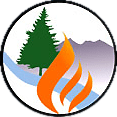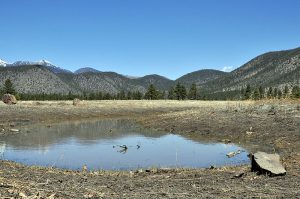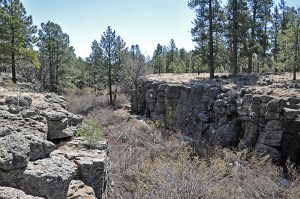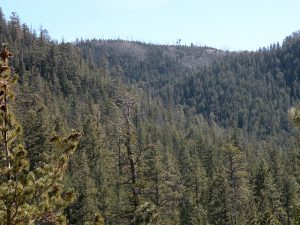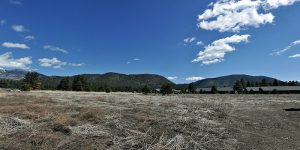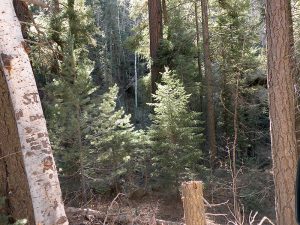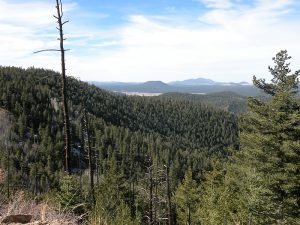This page contains answers and general information related to many of the Frequently Asked Questions we receive. We’ll update this page as more information is requested to help satisfy any inquiries you may have. If you have a question you’d like answered please contact us. You can also use this link to request email updates to the website as new information becomes available.
- Best Management Practices
- FWPP – What’s Going on? Updates to tree marking, what it means, and work on the ground
- Overview Information
- Project Area
- Project Finances
- Timeline
- Treatments
- Impacts
- Public Involvement
- Wildfire and Fire Restrictions
- Forest/Fire Ecology
- What is the difference between FWPP and Four Forest Restoration Initiative (4FRI)?
Overview Information
Why is this project needed?
Forests of the Intermountain West are threatened by a convergence of two significant factors: unnatural overstocking with small trees and weather conditions that contribute to the increasing severity, size and frequency of catastrophic wildfire. The combination of excess forest fuels (both surface fuels and excess trees); combined with the certainty of lightning- and human-caused ignitions, guarantee there will always be fire in our forests.
The City of Flagstaff’s bond funding will provide financial resources and voter support towards tackling those challenging elements of restoring forests within these high threat areas, providing greater protection for the Flagstaff community from the health, public safety and economic impacts of fires and floods.
The Flagstaff Watershed Protection Project (FWPP) will provide value added to two areas: The Rio de Flag and Lake Mary Watershed. Two specific and significant threats are posed by the poor health of Flagstaff’s adjacent forests present in these two areas.
What is the probability that severe fire and flooding will occur if nothing is done?
Frequent forest fires are the number one threat to the community of Flagstaff. The headwaters of Lake Mary, as well as the areas contributing to groundwater recharge for the City of Flagstaff’s well fields are similarly threatened. Research and experience tell us that we face a high probability of severe wildfire and flooding events will occur, but we can take preventative, pro-active, and risk reduction mitigation work to help minimize the threat.
By conducting ecologically appropriate thinning and burning, the occurrence and cost of unnaturally large and damaging wildfires can be greatly reduced. Research and experience have shown that acres burned and associated costs are greatly reduced in treated areas as compared to non-treated areas.
Who would be affected by the fires and flooding?
Fire could immediately impact every area resident and visitor, to include evacuation, heavy long-duration smoke, potential neighborhood damage or loss, devastation of our cherished scenic view, and decline in business activity, home values, and tourism revenue. Flooding in the Rio, coming from the watershed being severely-burned, is estimated to be upwards of ten times the 100-year flood event, posing risk to many neighborhoods throughout the community, including Cheshire, Coconino Estates, downtown, Sunnyside, and damaging much of the Northern Arizona University (NAU) campus. Fires and subsequent flooding at Lake Mary would result in loss of storage capacity in the reservoir and impact water quality. These impacts would require the City to immediately seek alternate water sources (new wells) or incorporate significant engineering and filtration redesigns into the Lake Mary Water Treatment Plant.
To fully calculate the costs associated with unnatural wildfires, the impacts to watersheds, ecosystems, infrastructure, businesses, tourism industries, individuals, and the local and national economy must be included. When all damage is considered, the true costs of wildfire become astronomical and are shown to be 2 to 30 times greater than the fire suppression costs that are usually reported. In a 2003 study conducted by the City of Flagstaff and Greater Flagstaff Economic Council determined the negative economic impact of a serious fire (not including subsequent flooding impacts) in Flagstaff that destroyed 300 homes was predicted at over $60 million. In a more recent study, FWPP Cost Avoidance Study conducted by the AZ Rural Policy Institute at NAU, if the two watersheds were left untreated and were to severely burn, estimated costs ranged from $573 million to $1.2 billion.
Will this project help to protect my family, home, and neighborhood?
Yes. Our local experience has shown (Woody and Hardy fires), and experience throughout the Western U.S., that properly planned forest treatments have a significant effect on slowing and decreasing fire severity and subsequent flooding. In the absence of such treatments, fires can easily transition into destructive events such as the Rodeo-Chedeski, Schultz, and Wallow fires.
Aren’t others already planning to do forest treatment work in these areas?
Parallel with this proposed project is a regional undertaking known as Four Forest Restoration Initiative (4FRI). This 20 year effort, to restore over 2 million acres of northern Arizona pine forests over 20 years, was funded by the federal government in 2012. Furthermore, a contract was awarded in May 2012 under 4FRI to thin 300,000 acres throughout the greater Flagstaff-Williams area within the next 10 years.
Working with the Coconino National Forest, other large areas adjacent to, and within, these two critical watersheds are also planned for treatment. The City actively supports, the Greater Flagstaff Forests Partnership (GFFP), which is active in helping plan forest treatments and providing assistance for work on private lands within the area.
Where will this project take place?
Primarily the project will take place outside the City, mostly on the Coconino National Forest, but will also include AZ State Land. Efforts within the Rio de Flag watershed will occur mostly in the Dry Lake Hills area, located immediately north of, and within sight of, much of town. Additional project work will take place within the City, focused primarily on Observatory Mesa near Lowell Observatory. Project efforts within the Lake Mary watershed will take place south of town, between Lake Mary and Mormon Mountain.
Are there other communities with similar projects?
Yes – both the Denver (CO) Water Board and the City of Santa Fe (NM) have similar programs. Both have been underway for several years, and both are highly successful.
- This project is a high priority to reduce the potentially devastating impacts of wildfire and subsequent flooding to Flagstaff area residents.
- This project has become a reality through the successful partnership between the Coconino National Forest, the City of Flagstaff, and State of Arizona. Many other key groups contributed, and continue to remain engaged as well (Coconino County, NAU’s Ecological Restoration Institute (ERI), GFFP, Yes on 405 political committe and others)
- Over the last decade, a great deal of fuels treatment and forest restoration work has been completed by the City, State, and Forest Service and others to protect the greater Flagstaff area from the effects of wildfire but a great deal of work remains to be completed.
- A catastrophic fire occurring in the Rio de Flag watershed could result in subsequent flooding that scientific modeling indicates could be more than 10 times greater than the estimated 100 year flood.
- Severe flooding after catastrophic wildfire in the Rio de Flag/Dry Lake Hills could impact many neighborhoods throughout the community including Cheshire, Coconino Estates, Sunnyside, and damaging much of downtown and the NAU campus.
- Severe flooding after catastrophic wildfire in the Lake Mary Watershed/Mormon Mountain could produce flooding which could deposit ash and sediment into the Lake Mary Reservoir which provides 50% of the City’s water supply.
Why haven’t treatments in these areas happened sooner?
Previous efforts have been hindered due to wildlife, social concerns and a lack of economic incentive because of the low value of material and the high costs of necessary forest treatments on steep rocky terrain.Treatment in these areas would not be feasible without the support of the City bond funding and assistance from all the project partners.
Who’s in Charge?
There are four agencies (City, County, State, Federal) that are involved in the project, but who is in charge of the project?
FWPP is a collaborative effort with involvement of numerous partner agencies and organizations. The primary agencies responsible for funding, planning, and implementation are the Coconino National Forest, the Arizona Department of Forestry and Fire Management, and the City of Flagstaff.
Is the Navajo tribe supportive of the FWPP effort? Will the Navajo land in the middle of the project area be thinned as well?
From initial outreach efforts to the tribes, several have shown interest and have been responsive to the project. FWPP staff have met with Navajo Nation leaders and have been given permission to the City of Flagstaff to manage nearly 100 acres of the Navajo owned Brookbank Meadow property. The Coconino National Forest is also working with the Navajo Nation to develop a road use permit agreement.
Project Funding
Where does the project funding come from?
In November 2012, Flagstaff residents overwhelmingly voted to approve bond funding to provide up to $10 million to support forest restoration work within key watersheds on the Coconino National Forest and State Trust lands.
Project partners will contribute additional resources and help leverage future grant funding and seek other opportunities to contribute to this effort.
Will property taxes increase with this measure?
No, property taxes will not increase with this measure. The municipal bond supporting the FWPP is funded through a secondary property tax. In November 2012, when 74% of voters in the City of Flagstaff approved the bond measure, several existing bonds funded through this tax were expiring. The new voter-approved bond funding this project simply replaced these expiring bonds. As a result, the secondary property tax rates did not increase; it remained the same.
Is $10 million going to be enough money to complete the project?
The $10 million voter-approved bond will be used to conduct forest treatments in the steep, rocky terrain that may include cable logging, hand thinning and helicopter logging. Due to the steep slopes and difficult access to these areas, this project is expected to be more expensive than traditional mechanical, ground-based forest treatments. Planning efforts will consider a variety of options to most efficiently and effectively target and treat priority areas to achieve overall watershed protection goals.
To assure funding is sufficient, treatments will be prioritized in areas that contain the highest risk for uncharacteristic wildfire and to the community. This funding has created the opportunity to conduct accelerated forest treatments that would otherwise have not occurred. In addition, the bond funds have created an opportunity to leverage and expand the initial funding amount. Within three years, the FWPP leveraged close to $3 million of additional external funds in addition to large amounts of donated time and resources from various organizations. Opportunities to leverage additional external funds are expected to continue as the 8 to 10 year project moves forward.
What is the City’s role?
The City of Flagstaff will have primary oversight to the bond funded project. Working with the U.S. Forest Service and other private and non-profit partners, the City will have a key role in the planning, the implementation and the monitoring to ensure the project has the intended effect and taxpayer dollars are used efficiently.
What exactly will the City bond funds do?
The Flagstaff Watershed Protection Project was overwhelmingly approved by City voters with nearly 74% of the vote. The $10 million bond will be spent to plan, implement, and monitor forest treatments within two key watersheds on the Coconino National Forest and State Trust lands. The funding will Accelerate, Leverage, and Expand other planned treatments in these two watersheds.
Does the wood have any commercial value?
Due to a limited local market and few utilization opportunities, most of the wood removed in this project will have little to no value. In some cases, it may have some limited value, which will help reduce the treatment costs. In many areas, due to small size, steeper slopes, and difficulty of removing the material, it will not. Efforts (such as 4FRI) are underway to encourage private industry to create the capacity to utilize the trees and material removed in this project.
- The project team and partners will continue to seek grants and other outside funding sources for associated efforts such as monitoring projects and outreach efforts.
- The likely cost of inaction far exceeds the cost of these proactive forest restoration treatments.
- This project will result in a healthier forest with a greatly reduced risk of severe wildfire, subsequent flooding and associated response and recovery costs.
Project Area
How were the two watersheds identified as priority treatment areas?
Both the Dry Lake Hills area (Rio de Flag watershed) and the Mormon Lake watershed were first identified as priority areas in the Greater Flagstaff Area Community Wildfire Protection Plan, approved by the City and County, and others, in late 2004 – early 2005. Their importance and vulnerability was clearly apparent following the Schultz Fire (2010) and subsequent flood events (2010 – present).
- The FWPP project area included a patchwork of areas analyzed in previous projects approved under the National Environmental Policy Act (NEPA). Areas approved through the Four Forest Restoration Initiative (4FRI) NEPA, and the new NEPA analysis under the Final Record of Decision are being consolidated under one implementation plan for a total of approximately 10,500 acres on federal land, 3,000 acres on state land and 2,000 acres on city land.
- Depending on operational conditions and terrain complexity, portion of the FWPP footprint may not be able to be treated.
- Much of the project area includes dense forest on very steep and rocky slopes.
- The terrain and vegetation in these areas add to the complexity of this project. Challenges include operability in dense forest and extremely steep slopes, as well as the need to mitigate impacts to threatened species such as the Mexican spotted owl.
- Mixed conifer has a different fire regime than the ponderosa pine forests typically treated in this area. It’s a forest type that hasn’t often been analyzed or treated in the Southwest.
What types of trees are in the project area?
The FWPP project areas contain a variety of trees, with the vast majority of trees to be thinned being Ponderosa pine. Across the project, there are instances of pinion pine, limber pine, aspen, Gambel oak, Douglas fir, white fir, sub-alpine fir, cork bark fir, Engelmann spruce, blue spruce, alligator juniper, rocky mountain juniper and Utah juniper.
What size trees will be removed?
The ecological and science-based focus of forest restoration efforts is on removal of excess small-diameter trees. While there is no set diameter cap for the FWPP project, the majority of trees removed will be generally less than 16 inches (diameter at breast height) in size. Developing industry is also, by contract, focused on products that can be produced using this smaller material. Larger trees are an important and vanishing segment of our forests, and they are to be protected unless there is compelling reason to remove select individual trees.
Timeline
When will work begin, and end?
Project planning efforts began immediately after voter approval and NEPA planning on federal land was completed in Oct. 2015. Field operations in several pre-approved locations and on city and state lands began in the summer of 2013. Once underway, completion of initial treatment activities in both watersheds will take an estimated 8-10 years.
- Planning and implementation efforts will be ongoing for several years. It began with an environmental analysis process – now completed – that evaluated the various potential treatments, which could include traditional logging, prescribed fire, helicopter logging and cable logging. This process provided the opportunity for public comment.
- Some areas and treatments within the project boundary that had already been approved under previous NEPA analyses began on-the-ground implementation after the bond had passed.
Treatments
What is meant by “forest treatments”?
Forest treatments primarily select removal (thinning) of excessive trees that is focused on small-diameter trees and debris (slash) disposal. This is followed by controlled burning to remove remaining unwanted material (pine needles, branches, pine cones, etc.). These treatments will cause productivity in the forest under story (grass, forbs, flowers) to flourish.
What treatment methods will be used?
All treatment options have been analyzed – including traditional logging, hand thinning, prescribed fire, steep slope equipment logging, helicopter logging and cable logging.
- Due to terrain complexity, some areas within the project footprint will not be treated.
- Different areas will require different approaches; the overall project will end up including a combination of treatment methods.
- The efforts will include treating areas that are approved in the Final Record of Decision and accelerating treatments currently being analyzed under the Four Forest Restoration Initiative (4FRI).
- Planning the treatments is a science-based, multi-disciplinary process.
- Specialists from all programs including fire, engineering, wildlife, archaeology, botany, silviculture, and recreation work together to develop treatment options.
- Results of treatments include a reduced risk of catastrophic wildfire and subsequent flooding, increased resistance to drought, insects and disease, increased quality to wildlife habitat, greater aesthetic values and an overall safer and more sustainable community.
- The treatments implemented will not prevent wildfires from occurring; but will help reduce the risk of catastrophic fire behavior and post-fire flood effects on the community and water supplies.
- The focus of forest treatment efforts is on removal of excess small-diameter trees, generally less than 10 inches (diameter at breast height) in size.
- Larger trees are an important and vanishing segment of our forests and they will be protected unless there is compelling reason to remove select individual trees.
Which treatment areas have priority and how does 4FRI factor in to that priority?
Within FWPP, Observatory Mesa, and the Dry Lake Hills portion of the project area are the first
priority for treatment, followed by Mormon Mountain near Lake Mary. 4FRI is also
prioritizing treatments within the Rio de Flag (e.g. Orion Task Order) and Upper Lake Mary watersheds and the efforts of FWPP and 4FRI are complementary.
Are there any plans to maintain the project, after the initial treatments are done?
Yes. To protect our investment in this project, and to ensure the continued health of our forests and watersheds, routine on-going maintenance (prescribed fire, thinning) of the treatments will be required. Maintenance is far less expensive than initial treatment work and will not begin for 7-10 years after completion of the initial work.
Impacts
Will there be any impacts to my use of these areas during this project?
Some temporary and localized impacts are inevitable during the implementation phase of this project. A project such as this cannot occur without some impacts although the project team will work to reduce these impacts and ensure they are known and well communicated well in advance. We feel such temporary inconveniences are well worth the tradeoff to reduce the risk of devastating and long term impacts of fire and flooding this project aims to reduce.
- Given the proximity to Flagstaff and the popularity of the area, this project will be highly visible to the public.
- The public can expect temporary closures; trail reroutes, and, depending on treatments approved, smoke, heavy equipment and logging trucks on popular roads, and machine noise.
- We’ll take every measure we can to minimize the impacts to the community and communicate these potential impacts well in advance.
Where will the logging/haul routes be located?
The Project team is working with the City, County, and local residents to determine specific details. Haul routes will become available as the project moves forward.
Will forest roads be damaged?
Heavy truck traffic and machinery can take their toll on forest roads, however, contractors are held responsible for restoring roads when they’re through.
- In some cases, forest roads may not be able to sustain such traffic in their current state, so roads have been improved (e.g. the Schultz Pass Road).
Will you be creating new roads for this project?
Efforts are taken to use existing routes wherever feasible, but some temporary roads will be constructed.
- It’s possible that some roads in the area could be in better shape than before – having to be improved to sustain truck traffic – and there may be opportunities for some roads to be decommissioned and used for non-motorized trails.
Will areas be closed? Where?
For public and crew safety, we’ll likely have to implement temporary closures in portions of the project. If and when we plan to close certain areas, we’ll update our website or you can call the Flagstaff Ranger District.
- Visitors are still responsible for knowing conditions and being prepared whenever they head to the forest. If you’re planning to visit the Dry Lake Hills or Mormon Mountain, KNOW BEFORE YOU GO.
What will happen to the hiking trails in the area?
Some trails will be temporarily closed and others will be rerouted. Stay tuned to the website, or call the Flagstaff Ranger District to check conditions before you head out.
If helicopter logging is used, will they fly over homes and roads?
No. To ensure public safety helicopters are not permitted to fly over homes and roads while conducting logging operations.
Will Mt Elden Dry Lake Hills Project (MEDL) continue now that FWPP is happening?
Yes, the MEDL project team will continue to move forward with planning and implementation. They’ll be in close coordination with the FWPP.
How will MEDL and FWPP affect each other?
The MEDL and FWPP teams are continuing to work closely together throughout both planning and implementation processes. We’ll try to look for opportunities where any changes to the landscape – such as roads and staging areas – from the FWPP could be used for trail/trailhead enhancements under MEDL.
Public Involvement
Public involvement is a key element in this endeavor. We encourage the public to be actively engaged throughout the process – get up-to-date information online, attend public meetings and field tours and contact us anytime throughout the project.
- We encourage the public to be actively involved in the project throughout the process. Your input is crucial to the success of the project.
Where can I find additional information on the FWPP?
A wealth of information is available on our website including a calendar of events, monitoring information and news releases. Additional material will be added as the project progresses and new information becomes available.
You can also call:
- Coconino National Forest at (928) 526-0866 or,
- Flagstaff Fire Department at (928) 213-2500
Wildfire and Fire Restrictions
Are you going to look into fire restrictions in Dry Lake Hills? Will campfire restrictions take place on a year-round basis?
Under Forest Order # 04-13-09-F, campfires are prohibited year-round north of Flagstaff between the Kachina Wilderness and the City boundary. This area includes Mount Elden and the Dry Lake Hills. As part of the FWPP, this restriction is permanent and campfires are banned throughout the Dry Lake Hills area. Camping, campfires and open burning are always prohibited within the City of Flagstaff municipal boundary.
REMEMBER: There is always at least one fire regulation in place — campfires must be out — COLD TO THE TOUCH — before being left unattended.
Visit the Coconino National Forest website for current wildfire and fire restriction information. Visit the City of Flagstaff website for fire restriction infomation withn the city.
General Forest/Fire Ecology
- Low intensity wildfires were once a natural and integral part of our forests which evolved with fire.
- Fire is natural and crucial to the health and sustainability of our forests, which depend upon and evolved with fire to maintain its natural structure, functions and processes.
- Natural fires once burned every 2-10 years on average in the ponderosa pine and were beneficial to maintaining a more open forest structure, recycling nutrients into the soil and eliminating accumulated forest debris which fuel severe wildfires.
- The current unhealthy conditions in our forest are a result of 100+ years of past land management, which included livestock grazing, industrial logging and aggressive fire suppression.
- The poor state of today’s forests increases the risk of insect damage, disease and destructive wildfire.
- Forest treatments serve a dual purpose.—.both increasing forest health and reducing fire risk.
- Forest restoration activities will not eliminate wildfire from our forests, but will greatly reduce the risk of unnaturally severe wildfire and associated impacts such as flooding.
Can you quantify the reduction of fire risk when it comes to thinning?
The FWPP team has developed a monitoring plan that includes changes in fire behavior. Quantifying reduction of fire risk is expected to be determined with pre- post-monitoring. To accomplish this, on-the-ground measurements for fire modeling is needed before and after treatments. This data will be entered in to fire modeling software, which will quantify fire reduction for specific forest treatments.
What is the difference between FWPP and 4FRI?
The Flagstaff Watershed Protection Project (FWPP) is a local project that was voted on by residents of Flagstaff in the City’s November 2012 election. Voters overwhelmingly approved a $10 million bond to support forest restoration work within key watersheds on the Coconino National Forest and State of Arizona lands. The FWPP project area is located north of Flagstaff in the Dry Lake Hills and south of Lake Mary at Mormon Mountain. The primary agencies involved are the Coconino National Forest, the City and the State. The total project size is approximately 15,300 acres.
The Four Forest Restoration Initiative (4FRI) is a completely separate project; however, both projects are complimentary to one another. The 4FRI Project is a federally funded Collaborative Forest Landscape Restoration Project (CFLRP). The 4FRI is a collaborative effort to restore forest ecosystems on portions of four national forests – the Coconino, Kaibab, Apache-Sitgreaves and Tonto – along the Mogollon Rim in northern Arizona. The 4FRI project will plan and implement restoration treatments across 2.4 million acres of ponderosa pine forest by treating approximately 30,000 acres per year during a 20-year period.
